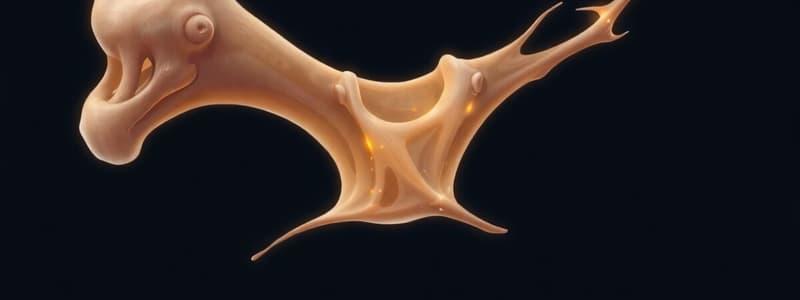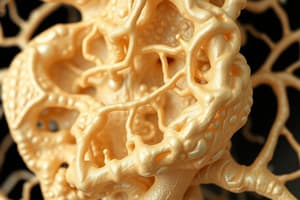Podcast
Questions and Answers
Which component of the bone matrix primarily provides flexibility and tensile strength?
Which component of the bone matrix primarily provides flexibility and tensile strength?
- Ground substance
- Hydroxyapatite crystals
- Collagen fibers (correct)
- Calcium carbonate
How do osteoclasts contribute to bone remodeling?
How do osteoclasts contribute to bone remodeling?
- Initiating intramembranous ossification
- Maintaining the bone matrix
- Synthesizing new bone matrix
- Resorbing existing bone tissue (correct)
What is the primary function of the Haversian canal in compact bone?
What is the primary function of the Haversian canal in compact bone?
- Facilitating bone resorption
- Containing blood vessels and nerves (correct)
- Housing osteocytes
- Providing space for bone marrow
In endochondral ossification, what role does the primary ossification center play?
In endochondral ossification, what role does the primary ossification center play?
Which type of bone growth increases bone thickness?
Which type of bone growth increases bone thickness?
What characterizes spongy bone and distinguishes it from compact bone?
What characterizes spongy bone and distinguishes it from compact bone?
What is the role of the epiphyseal plate during bone development?
What is the role of the epiphyseal plate during bone development?
Which of the following is NOT a function of bone?
Which of the following is NOT a function of bone?
How do nutrients reach osteocytes within the trabeculae of spongy bone?
How do nutrients reach osteocytes within the trabeculae of spongy bone?
Which of the following characteristics distinguishes elastic cartilage from hyaline cartilage?
Which of the following characteristics distinguishes elastic cartilage from hyaline cartilage?
What is the primary mechanism by which nutrients reach chondrocytes in cartilage tissue?
What is the primary mechanism by which nutrients reach chondrocytes in cartilage tissue?
In appositional growth of cartilage, where does the new cartilage matrix get added?
In appositional growth of cartilage, where does the new cartilage matrix get added?
What is the role of canaliculi in compact bone?
What is the role of canaliculi in compact bone?
What type of cartilage is best suited to resist compression and provide cushioning in joints, such as in intervertebral discs?
What type of cartilage is best suited to resist compression and provide cushioning in joints, such as in intervertebral discs?
Which of the following describes the function of Volkmann's canals?
Which of the following describes the function of Volkmann's canals?
What is a key difference between interstitial and appositional growth of cartilage?
What is a key difference between interstitial and appositional growth of cartilage?
Flashcards
Bone
Bone
Rigid tissue providing support, protection, and enabling movement.
Cartilage
Cartilage
More flexible tissue that cushions and supports specific body areas.
Osteocytes
Osteocytes
Mature bone cells embedded in the bone matrix.
Osteoblasts
Osteoblasts
Signup and view all the flashcards
Osteoclasts
Osteoclasts
Signup and view all the flashcards
Compact Bone
Compact Bone
Signup and view all the flashcards
Spongy Bone
Spongy Bone
Signup and view all the flashcards
Osteons
Osteons
Signup and view all the flashcards
Canaliculi
Canaliculi
Signup and view all the flashcards
Volkmann's Canals
Volkmann's Canals
Signup and view all the flashcards
Interstitial Lamellae
Interstitial Lamellae
Signup and view all the flashcards
Trabeculae
Trabeculae
Signup and view all the flashcards
Cartilage Tissue
Cartilage Tissue
Signup and view all the flashcards
Hyaline Cartilage
Hyaline Cartilage
Signup and view all the flashcards
Elastic Cartilage
Elastic Cartilage
Signup and view all the flashcards
Appositional Growth
Appositional Growth
Signup and view all the flashcards
Study Notes
- Bone and cartilage are specialized connective tissues in the skeletal system.
- Both provide support and structure to the body.
- Bone is a rigid tissue providing support, protection, and locomotion.
- Cartilage is more flexible, providing cushioning and support in specific areas.
Bone Tissue
- Bone consists of cells, fibers, and ground substance.
- The extracellular matrix is mineralized, making bone hard and rigid.
- Bone matrix consists of both organic and inorganic components.
- Organic components mainly consist of collagen fibers, providing flexibility and tensile strength.
- Inorganic components primarily consist of calcium phosphate in the form of hydroxyapatite crystals, providing rigidity.
- Osteocytes are mature bone cells.
- Osteoblasts synthesize bone matrix.
- Osteoclasts resorb bone.
- The periosteum is a connective tissue covering on the outer surface of bones.
- Endosteum is a single layer of cells lining the inner cavities of bone.
Types of Bone
- Compact bone is dense.
- Spongy bone is also known as cancellous bone.
- Compact bone forms the outer layer of bones.
- Spongy bone is found in the interior of bones.
- Compact bone provides strength and resistance to bending.
- Spongy bone contains trabeculae, which are bony spicules that create space for bone marrow.
- Bone marrow is responsible for hematopoiesis.
- Long bones have a diaphysis (shaft) and epiphyses (ends).
- The metaphysis is the region between the diaphysis and epiphysis during bone development, containing the epiphyseal plate (growth plate).
Bone Development
- Ossification is bone formation.
- Intramembranous ossification occurs when bones form directly from mesenchymal tissue.
- Endochondral ossification occurs when bones form from a cartilage template.
- Flat bones of the skull develop through intramembranous ossification.
- Most bones develop through endochondral ossification.
- Primary ossification center is in the diaphysis during endochondral ossification.
- Secondary ossification centers appear in the epiphyses.
- The epiphyseal plate allows long bones to grow in length.
- Appositional growth increases bone thickness.
- Bone remodeling involves bone resorption by osteoclasts and bone deposition by osteoblasts.
- Remodeling occurs throughout life, allowing bone to adapt to stress.
Microscopic Structure of Compact Bone
- Osteons (Haversian systems) are the basic structural units.
- Osteons consist of concentric lamellae, which encircle a central Haversian canal.
- Haversian canals contain blood vessels and nerves.
- Osteocytes reside in lacunae between lamellae.
- Canaliculi are small channels that connect lacunae, allowing for nutrient and waste exchange.
- Volkmann's canals connect Haversian canals to each other and to the periosteum.
- Interstitial lamellae are remnants of old osteons.
Microscopic Structure of Spongy Bone
- Trabeculae are composed of lamellae.
- Trabeculae are oriented along lines of stress to provide strength.
- Osteocytes are located within lacunae in the trabeculae.
- Nutrients reach osteocytes by diffusion through canaliculi that open onto the surface of trabeculae.
- Spongy bone contains bone marrow between trabeculae.
- Spongy bone is lighter than compact bone, reducing overall weight.
Cartilage Tissue
- Cartilage consists of cells (chondrocytes), fibers, and ground substance.
- Cartilage matrix is firm but flexible.
- Cartilage lacks blood vessels and nerves (avascular).
- Nutrients reach chondrocytes by diffusion through the matrix.
- Chondrocytes reside in lacunae within the matrix.
- Perichondrium is a layer of dense connective tissue that surrounds cartilage, providing nutrients and support.
Types of Cartilage
- Hyaline cartilage is the most common type.
- Elastic cartilage is more flexible.
- Fibrocartilage is the strongest.
- Hyaline cartilage is found in articular surfaces, the nose, and the trachea.
- Elastic cartilage is found in the ear and epiglottis.
- Fibrocartilage is found in intervertebral discs and menisci.
Hyaline Cartilage
- Hyaline cartilage has a glassy appearance.
- Contains moderate amount of collagen fibers.
- Provides smooth surfaces for joint movement.
- Important in bone development and growth.
Elastic Cartilage
- Elastic cartilage contains numerous elastic fibers.
- More flexible than hyaline cartilage.
- Provides support and maintains shape.
Fibrocartilage
- Fibrocartilage contains a large amount of collagen fibers.
- Very tough and resistant to compression and tension.
- Provides support and cushioning in joints.
- Intervertebral discs contain fibrocartilage, acting as shock absorbers.
Cartilage Growth
- Appositional growth involves new cartilage matrix being added to the surface of existing cartilage.
- Interstitial growth involves chondrocytes dividing and secreting new matrix within existing cartilage.
- Cartilage has limited capacity for repair.
- Damaged cartilage is often replaced by fibrocartilage scar tissue.
Studying That Suits You
Use AI to generate personalized quizzes and flashcards to suit your learning preferences.




